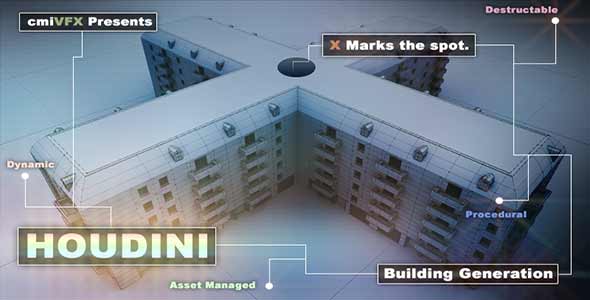
This is my second video course of the series of Houdini tutorials, in which I will be talking about city generation. In this video I am going to teach you how to create a PROCEDURAL CUSTOMIZABLE building.
Buying expensive software to generate cities? Well now you can create buildings right inside of Houdini. Do this interactively and customize the buildings via Assets for new and unique structures. This video will teach you how to create a PROCEDURAL and CUSTOMIZABLE building. Not only you will have the option to change the pre-existing set of parameters, but most importantly you can yourself create, remove or modify the assets which are the actual bricks that constitute the building, ranging from doors to balconies to anything you can think of, they will be directly taken into account and parameters automatically created for them. So that you will be able to modify the general building parameters and the parameters for YOUR assets as well to customize even more the result you have. You can even build asset libraries and with a few clicks switch from one library to another to get a whole new result. If you’re going to be in this industry…. this is the video that you want in your library.
The first step in the process is to get the outer outline shape of the building. That can be done in many ways. You’re going to learn in this part how to do that the direct way and then how to replace that with syntax based system to make the outline shape generation the best and most flexible it can be. For the syntax based method a mix between python coding and basic workflow will allow us to get the desired result. While a human can control the result, when the process is automated undesired results may happen, unless some special conditions are added to the input parameters, which will be discussed as well.
After creating the outline shape of the building, the dummy grid facades that were used, have to be replaced with real facades. To build the real facades there is a lot of possibilities. Some of those possibilities will be explored, among which some are simpler than others and can serve to be used in simple situations where not much complexity is needed, and the last one on which the choice is set for the final building is more complex than all the other methods but is far more flexible and controllable. Here as well python code will be used to participate as a part in a hole in the façade creation. A very important aspect of the building is defined here, which is the customizability of the components of the building, so you’re going to see how the assets system works and how much power, control and flexibility it gives to our building. And at the end you will see how all that adds up to replace the grid facades with the real facades and approach the final shape.
At this point the building is a hollow shape without a roof, so this part will walk you through the creation of the floors separators which will form the ground for each one of the floors, and using almost the same techniques the roof is going to be created. Sometimes getting the desired result becomes a little tricky, and colors can help you greatly while debugging, this is why you’re going to see how to add some colors to your building based on many parameters such as colorizing per floor, per façade or per wall.
Now that the building is all done, comes the parameters turn. The parameters are a very important aspect of the building, and they can be divided into two big families, the first is the standard building parameters that are there all the time, and the second family is the parameters that are generated or removed on the fly whenever you create or remove an asset of your building assets folder. Some of the parameters need to generate an event that calls a callback script that will update the building and depending on the scenario this can be tricky so you’re going to see a couple of methods of how to do that and how to implement conditions into that as well. And of course using python code you’re going to see how to generate the corresponding assets parameters on the fly.
The last part of our journey will be more like an exercise, where you will be trying to use the building, by seeing how to add assets, how to use their parameters to control their use throughout the building. Like any other system, this system has some Dos and Donts that will be discussed here. And at the end we’re going to talk briefly about creating multiple different copies of our building using a copy node and stamp functions.